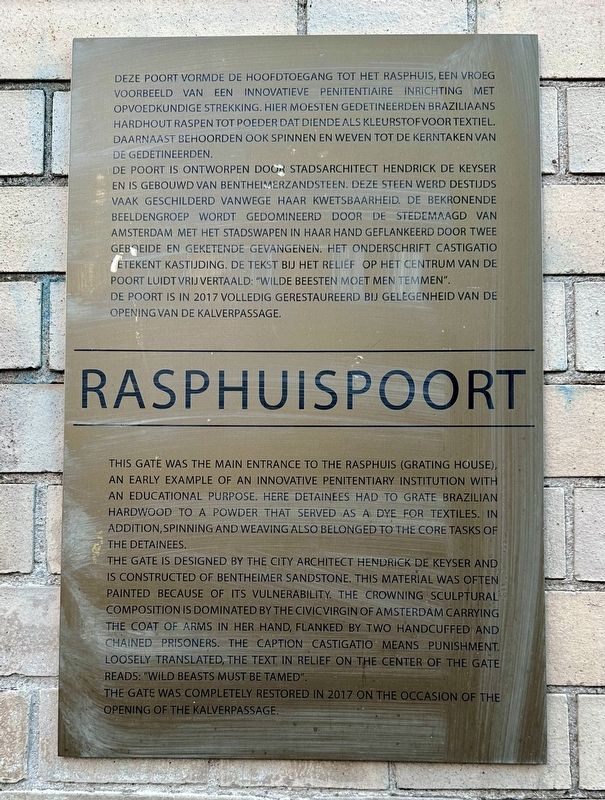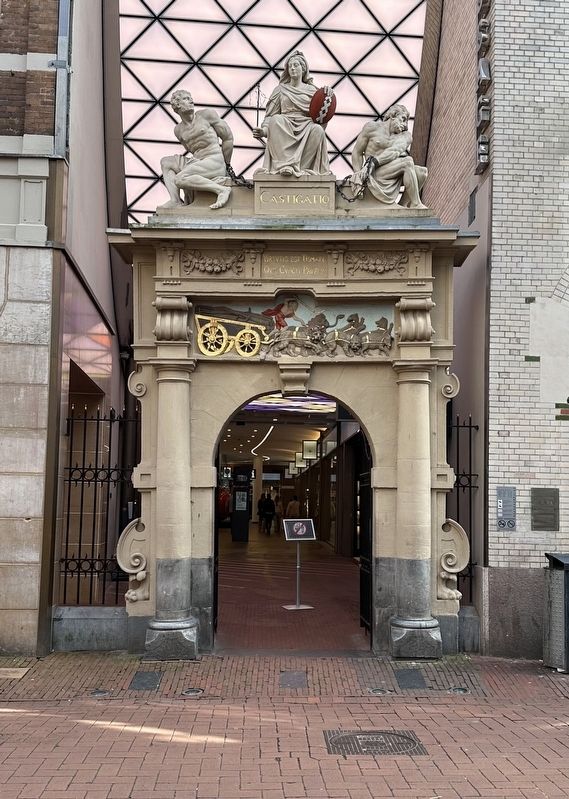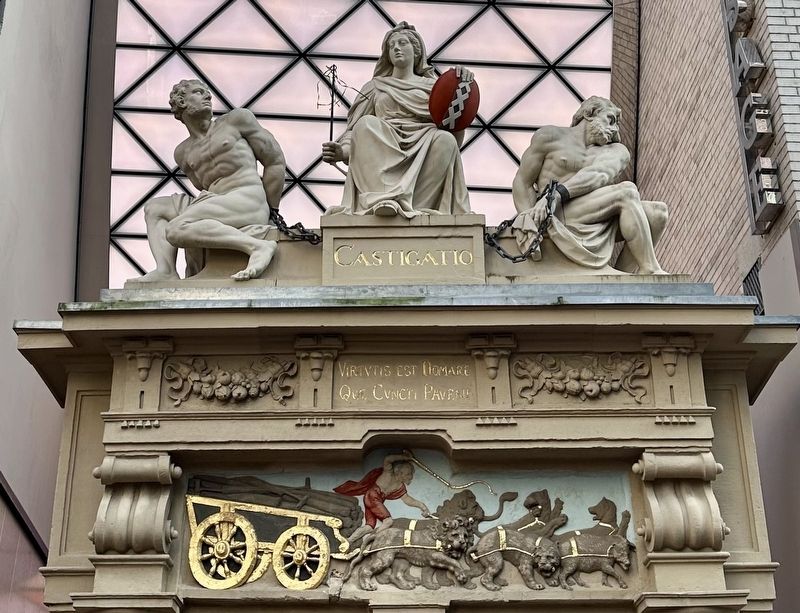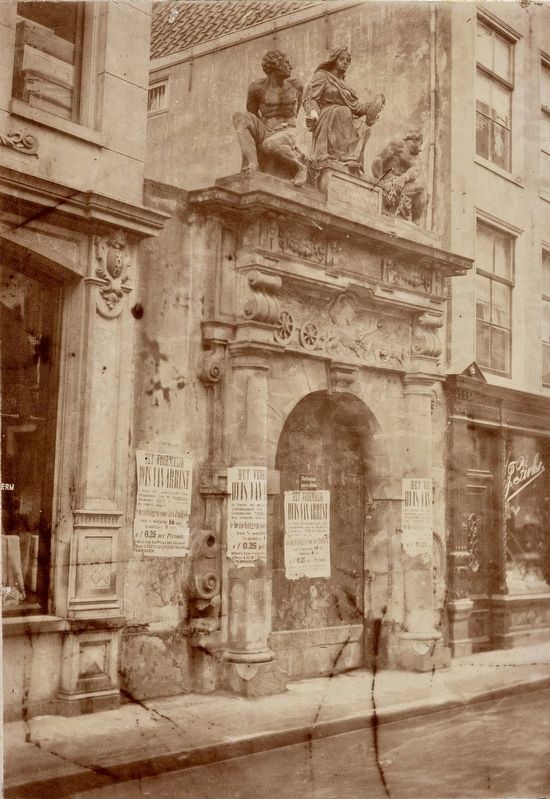Binnenstad in Amsterdam, North Holland, Netherlands — Northwestern Europe
Raspuispoort / “Grating House” Gate
De poort is ontworpen door stadsarchitect Hendrick de Keyser en is gebouwd van bentheimerzandsteen. Deze steen werd destijds vaak geschilderd vanwege haar kwetsbaarheid. De bekronende beeldengroep wordt gedomineerd door de stedemaagd van Amsterdam met het stadswapen in haar hand geflankeerd door twee gebreide en geketende gevangenen. Het onderschrift castigatio etekent kastijding. De tekst bij het relief op het centrum van de poort luidt vrij vertaald: "wilde beesten moet men temmen".
De poort is in 2017 volledig gerestaureerd bij gelegenheid van de opening van de Kalverpassage.
This gate was the main entrance to the rasphuis (grating house), an early example of an innovative penitentiary institution with an educational purpose. Here detainees had to grate Brazilian Hardwood to a powder that served as a dye for textiles. In addition, spinning and weaving also belonged to the core tasks of the detainees.
The gate is designed by the City Architect Hendrick de Keyser and is constructed of Bentheimer Sandstone. This material was often painted because of its vulnerability. The crowning sculptural composition is dominated by the Civic Virgin of Amsterdam carrying the coat of arms in her hand, flanked by two handcuffed and chained prisoners. The caption castigatio means punishment. Loosely translated, the text in relief on the center of the gate reads: "wild beasts must be tamed".
The gate was completely restored in 2017 on the occasion of the opening of the Kalverpassage.
Topics. This historical marker is listed in these topic lists: Architecture • Industry & Commerce • Law Enforcement.
Location. 52° 22.065′ N, 4° 53.462′ E. Marker is in Amsterdam, Noord-Holland (North Holland). It is in Binnenstad. Marker is at the intersection of Heiligeweg and Voetboegstraat, on the right when traveling east on Heiligeweg. Touch for map. Marker is at or near this postal address: Heiligeweg 20, Amsterdam, Noord-Holland 1012 XS, Netherlands. Touch for directions.
Other nearby markers. At least 8 other markers are within walking distance of this marker. Het Begijnhof (about 180 meters away, measured in a direct line); Gisèle (approx. 0.3 kilometers away); Gerrit van Arkel (1858-1918) (approx. 0.3 kilometers away); In Gratitude for the Dutch Support of the American Revolution (approx. 0.3 kilometers away); Elisabeth van Oostenrijk / Empress Elisabeth of Austria (approx. 0.3 kilometers away); Doelentoren
(approx. 0.3 kilometers away); Joes Kloppenburg (approx. 0.3 kilometers away); Gemeente Amsterdam Stadsarchief / Amsterdam City Archives (approx. 0.4 kilometers away). Touch for a list and map of all markers in Amsterdam.
Also see . . .
1. Raspuisportje (Wikipedia, in Dutch).
Origin and meaning (in translation): The gate dates from around 1603 and was the outer of two gates, the inner one of which has long since disappeared. The gate was made by Hendrick de Keyser in the Mannerist style. The relief above the round arch and above the Doric half-columns is an image of a chariot loaded with Brazilian wood pulled by lions, bears, wild boars and tigers. There is a driver on the wagon who tames the animals with a whip.(Submitted on March 20, 2024.)
On the entablature there are three statues from the third quarter of the 17th century, which were installed later, possibly designed by De Keyser. The seated woman, possibly an image of the city virgin, holds the city coat of arms on her knee and a whip in her right hand. By adding the word Castigatio she is referred to as the symbol of chastisement. Two naked men kneel at her flanks, bound with chains.
2. Tile Heiligeweg: Koerbagh (Vrijheid van Amsterdam / Freedom of Amsterdam).
Excerpt: It does not make something true, or change a thing in any way, to say I cannot understand it but I believe it, these are mere empty words that signify nothing. (1668)(Submitted on March 20, 2024.)
This quote shows how doctor, lawyer and philosopher Adriaan Koerbagh fought for thinking for yourself, and warned against on good faith assuming things to be true. He placed using your own reason above dogma, and thought religion was irrational. He is seen as a radical freethinker. He was punished for his freethinking by being locked up in the Rasphuis, a prison where he had to grate wood that was used as a coloring agent. He died a year later because of the hard working conditions. This shows the limits of the press freedom in seventeenth-century Amsterdam. Although the freedom of the press was much greater than in other European cities, it was not nearly the same as we know it today.
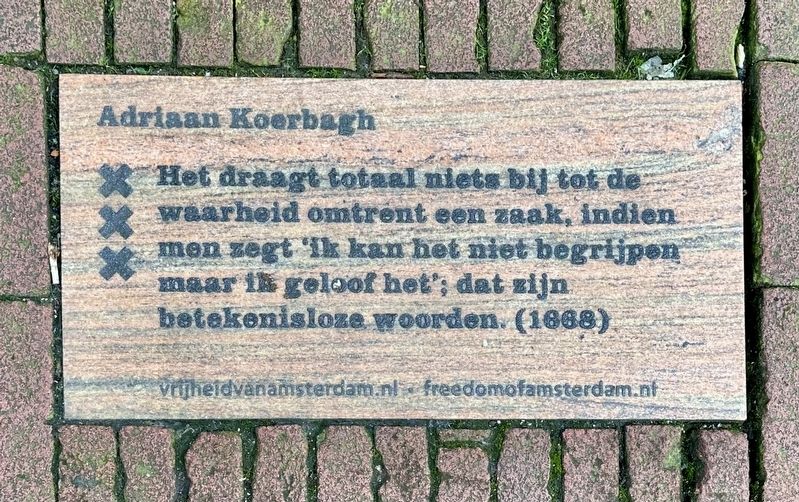
Photographed By Andrew Ruppenstein, March 18, 2024
5. Adriaan Koerbagh quote
Set in the pavement just to the left of the gate is a quote by the Amsterdam philosopher Adrian Koerbagh, as part of a larger set of tiles of quotes relating to freedom that are located throughout the city. Translated, the quote relating to religious belief reads, “ It does not make something true, or change a thing in any way, to say I cannot understand it but I believe it, these are mere empty words that signify nothing.” Koerbagh was considered a radical thinker and died in the Rasphuis prison for his writings. See the link provided for more information.
Credits. This page was last revised on March 20, 2024. It was originally submitted on March 20, 2024, by Andrew Ruppenstein of Lamorinda, California. This page has been viewed 44 times since then. Photos: 1, 2, 3, 4. submitted on March 20, 2024, by Andrew Ruppenstein of Lamorinda, California. 5. submitted on March 20, 2024.
